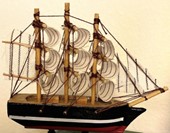Focus on Miniatures - Boats
Theresa Fraser, Associate Editor, Canada

There is evidence of boats being used as early as the neolithic period in a place that is now known as South Korea (Park et al, 2010). Have you ever travelled in a boat? Perhaps a large boat with a motor such as cruise ship, ferry, or a yacht. Or maybe you have been on a sailboat powered by wind, or a rowboat, kayak or canoe powered by you? Did it matter how it was powered? Or was it more important where the boat was going?
There can be lots of boats to choose from in the sandtray space. Big boats, small boats, red boats, blue boats. Some people live on boats, some work on boats, some use boats for travel and others are placed in a boat as their final resting place while they travel to the afterlife (Morgan, 2018). Boats float on water or can be stored on a stand while being winterized. Boats both hold and carry.
Sand Therapists who were members of the World Association for Sand Therapy were asked who chose boat miniatures in their sandtrays. All respondents shared that they journey with individuals under the age of 10 to the age of 65 as well as with family groups.
One therapist identified that boats were utilized when people are struggling with movement through life, when they feel stuck or conversely are experiencing growth and other life transitions. Journeyers may also be experiencing grief or anxiety or feel a lack of stability/control in the face of life changes if not turbulence. One therapist identified the theme of boats carrying slaves and another a boat sharing the expression of the need for self-care or a vacation. For some builder’s boats might communicate for them a sense of freedom.
When asked what specific themes the therapist thought the boat communicated, they included growth, traveling, movement, goals, after life/death/grief. Boats could also be a vessel to facilitate movement, transition, the need for constancy, capture, independence, or ambiguity.
It is clear therefore, that the boat can mean many things or different things to journeyers and the therapist (witness). We watch, we lean in, we ask if anyone knows where the boat is going or who is on it and we wait for the builder to identify if the boat is anchored or moving.
Later while reviewing our notes or the built sandtray itself, perhaps we imagine ourselves being in the boat while the water laps around us. Then the question becomes where do you want to go in a boat?
Thanks to these sand therapists for their contribution to this article:
Yolanda Fountain Hardy (USA)
Claudia Ocampo (USA)
Sara Stanley (Australia)
References
Gyujun Park, Jong-Chan Kim, Minyoung Youn, Chongcheol Yun, Jin Kang, Yong-Mi Song, Su-Jin Song, Hye-Jin Noh, Do-Kyun Kim, Hack-Jong Im, (2010). Dating the Bibong-ri Neolithic site in Korea: Excavating the oldest ancient boat, Nuclear Instruments and Methods in Physics Research Section B: Beam Interactions with Materials and Atoms, (268)7–8, 1003-1007, https://doi.org/10.1016/j.nimb.2009.10.084.
Morgan, T. (2018). How did the Vikings honor their dead? Most Vikings were sent to the afterlife in one of two ways. History Stories. Retrieved from www.history.com
© World Association of Sand Therapy Professionals, World Journal for Sand Therapy Practice, Volume 1, Number 2